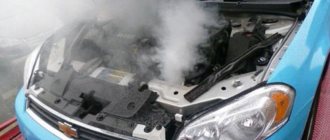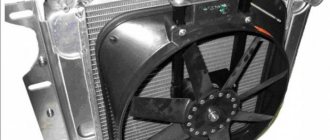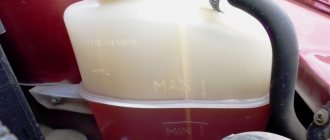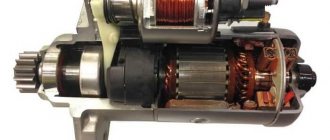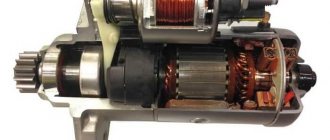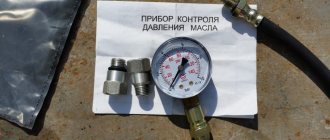Why does antifreeze boil? This situation can arise for a variety of reasons, for example, the cap of the expansion tank of the cooling system has depressurized, the thermostat has malfunctioned, the coolant level has decreased, bad antifreeze has been filled in, the cooling fan or temperature sensor has failed. The main thing that the driver of a car with antifreeze boiling must remember is that further movement is impossible! Failure to comply with this rule can lead to complete engine failure, which can lead to costly and complex repairs. However, eliminating the causes of antifreeze boiling is actually not that difficult, and sometimes even a novice car owner can do it.
VAZ-2114 – the engine gets hot: causes and repairs. Thermostat VAZ-2114
An internal combustion engine is called that because the process of fuel combustion occurs inside its cylinders. In this case, a huge amount of thermal energy is released, which, thanks to the crank mechanism, is converted into mechanical energy. The temperature often exceeds 2000 degrees. No metal, no matter how strong and stable it is, can withstand such a load for long. It is precisely in order to reduce the thermal load and ensure normal temperature conditions for engine operation that the cooling system serves. If it malfunctions, the car’s power unit begins to overheat, as a result of which engine parts expand, lubricant boils, and gaskets burn out. The result of such a destructive process may be failure of the elements of the piston group and the cylinder head. To prevent such an outcome, it is important to know the possible causes of engine overheating and be prepared to eliminate them immediately.
Boiling point of antifreeze
Initially, on the first cars, water was used as a coolant. The boiling point of water is 100 degrees Celsius. The reasons why it was decided to abandon water lay in its low boiling point, which was not designed for heavy loads, and its freezing in winter. After all, when it froze, it turned into ice, and its volume expanded significantly. Such phenomena led to the fact that the cylinder block simply cracked and the entire engine failed, the block of which could only be replaced.
Such disadvantages are absent in antifreeze. The fact is that antifreeze has a certain chemical composition that allows it to withstand fairly low temperatures, which makes it possible for the car to operate normally in winter. In addition, the boiling point of antifreeze is much higher than that of water and is 125 degrees Celsius.
However, such a value as temperature can vary from 108 to 125 degrees. This is due to the chemical composition of the coolant, which, accordingly, changes the boiling point. Changing the composition makes the production of antifreeze more economical, the price for it falls, but at the same time, the boiling point also decreases. Therefore, when buying antifreeze, you should not pay special attention to savings, since the proper cooling of your engine will depend on this.
You should be especially careful with antifreeze with qualitative inconsistencies. Typically, such coolant costs quite little, which is tempting for drivers. However, the boiling point of some specimens is even 85 degrees, which is dangerous for a car engine.
Therefore, be careful and do not buy low-quality coolant. This will save you a lot of nerves and money.
Signs indicating that the engine is overheated
Let's consider how the VAZ-2114 power unit behaves when its operating temperature exceeds the norm. The cooling system of this car is not much different from that of other cars, except perhaps in the simplicity and unreliability of its design. So, when the engine of the “fourteenth” overheats, it lets you know about it with the following signs:
- the arrow of the coolant temperature sensor goes far into the red zone;
- The radiator cooling fan operates in constant mode;
- a specific smell appears in the cabin from boiling antifreeze (antifreeze);
- A cloud of thick, sharp-smelling steam appears from under the hood - evidence of boiling refrigerant.
Preventive measures
To avoid cooling system malfunctions, you need to buy high-quality antifreeze from trusted auto stores and services. If everything worked before replacing the antifreeze, but after the replacement the system boiled, most likely the reason was poor-quality antifreeze.
A sign of fake antifreeze is its boiling over at a temperature on the dashboard of 90 °C. In this case, if the VAZ 2114 boils at 90 degrees, a complete drain of the fake and flushing of the entire cooling system is required.
When purchasing antifreeze, you need to pay attention to both the boiling point and boiling pressure. If the pressure does not match atmospheric pressure, recalculate the temperature. For example, at the promised 135°C-1.2 atm. antifreeze will boil at 100°C-1 atm (if the atmospheric pressure is normal, it will boil at 100°C).
During a daily inspection of the engine compartment with the engine running, you can detect fluid leaks, ruptures in connecting pipes and contamination of the radiator.
To prevent the engine from overheating, you need to set the fan activation temperature on the on-board computer to 95°C (change from the factory setting to 102-105°C).
What to do if you overheat
If, thanks to the listed signs, you understand that your VAZ-2114 engine is heating up more than normal, follow these steps:
- turn off the engine immediately;
- roll the car closer to the side of the road (if you are on the road);
- turn on the ignition and double-check the temperature sensor readings;
- lift the hood, inspect the engine compartment to determine the location of the coolant leak;
- pay attention to the amount of antifreeze (antifreeze) in the expansion tank, but under no circumstances open it while the liquid is hot;
- try to determine the cause of overheating.
In such a situation, it is better to deliver the car to the place of repair (to a service station or garage) by towing, but if this place is located no further than 1-2 km, as a last resort, you can take a risk and get there on your own. Naturally, periodically letting the engine cool down when the sensor needle exceeds 90 degrees.
What to do if antifreeze boils
However, the most interesting and interesting question for drivers is the following - what to do if antifreeze/antifreeze boils on the road or in a parking lot. The first thing to remember is not to panic, that is, to keep the situation under control! It is advisable to draw attention to the fact that the cooling system has partially failed as soon as possible. This can be done either using instruments on the panel or visually by looking at the steam coming out from under the hood. The sooner you take appropriate action, the greater the likelihood of getting away with inexpensive repairs.
There is a simple algorithm that every car enthusiast should know, even those who have never encountered a similar situation. It consists of the following steps:
- Switch to neutral speed and reduce engine speed to idle.
- Continue driving and do not suddenly slow down. The oncoming air will blow the engine as much as possible to cool it.
- While still driving turn on the interior heater to the highest possible temperature. Moreover, this must be done regardless of the time of year, that is, if necessary, even in the summer heat. This procedure is done in order to remove heat from the radiator as much as possible so that it cools down as much as possible at no-load speed.
- You need to roll for as long as possible, until it comes to a complete stop (if this happens in the summer, then it is advisable to find a stopping place somewhere in the shade , without direct sunlight). Afterwards the engine must be turned off. In this case, the ignition must be left on in order to allow the stove to work for another 5…10 minutes . After this, turn off the ignition.
- Open the hood in order to give maximum access to natural air into the engine compartment. Without touching any engine parts with your hands (now they are at an extremely high temperature), wait a certain time . In summer it is about 40...50 minutes, in winter - about 20. Depends on weather conditions and the time the car was “boiling”.
- Call a tow truck or a car that will tow the car to a service station or to a good mechanic with the appropriate diagnostic equipment.
Dirty radiator - If there are no cars nearby, then after the mentioned time, making sure that there is no more boiling and the liquid has “calmed down,” carefully unscrew the cap of the expansion tank of the cooling system and add clean water . If you are traveling close, you can use some non-carbonated drinks. Fill to the mark.
- Start the car, turn on the heater to maximum and continue driving at low speeds. As soon as the coolant temperature reaches +90°C, you need to stop and wait again for about 40 minutes . If you're not far away, you're in luck. Otherwise, you need to look for an option with a tow truck or tug.
- Upon arrival at the service station, tell the technicians about the problem; usually they can easily find the breakdown (among those described above) and fix it.
- Also be sure to ask them to change the antifreeze , since the liquid that is currently in the system has already lost its performance properties.
- Carry out a breakdown diagnosis in order to find the cause of the boiling and eliminate it so that the situation does not recur in the future.
The algorithm of actions is simple, and even an inexperienced driver can cope with it. The main thing is to notice the process of antifreeze boiling in time. And it is advisable to always have a small supply of coolant (similar or compatible with that currently used) in the trunk, as well as engine oil. The canister does not take up much space, and can come in handy at a critical moment.
Why does the engine on a VAZ-2114 get hot?
Considering that the cooling system of the “fourteenth” is quite simple, it is quite possible to bring it into working condition on your own. But first, let's look at the main reasons for engine overheating. They can be:
- insufficient amount of coolant in the system;
- the liquid pump (pump) is faulty;
- The radiator fan switch sensor has failed;
- blown fan fuse;
- the fan itself is broken;
- the radiator fins are clogged;
- The thermostat has failed;
- The expansion tank plug is faulty.
Let's look at these reasons in more detail.
Driver actions
Having noticed that antifreeze begins to boil in the expansion tank, you need to take a number of mandatory measures. Don't wait for the coolant to start splashing out onto the hot engine. Once the liquid boils, there are corresponding reasons.
Pour antifreeze into the car
You already know at what temperature antifreeze usually boils in cars, what causes overheating and what consequences this can lead to. Therefore, no one wants to encounter something like this in their own car. It is necessary to start cooling the engine using available methods, not forgetting that the coolant is now under high pressure.
There are several useful tips and a certain algorithm of actions that allows even a beginner to figure out what to do if antifreeze suddenly boils.
- Be sure to try to quickly unload the engine. To do this, you can put the gearbox in neutral and drive until it comes to a complete stop.
- Turn on the fan and stove at the same time. Even if it’s hot outside, the heater will take away some of the heat, thereby speeding up the process of the engine temperature dropping.
- After stopping the car, turn off the engine. At the same time, leave the stove in working condition.
- Pull the handle or press the button to open the hood from the passenger compartment and access the engine compartment. There is no need to stand in front of the hood and open it, as hot steam will immediately come out.
- By opening the hood slightly, steam will come out and fresh air will begin to flow into the engine. Wait a while. Then lift the hood and lock it. It is better to have gloves or a rag with you so as not to grab possibly hot elements with your bare hands.
- Do not try to open the expansion tank cap immediately. Otherwise, you risk your own health. Liquid under pressure, even if the lid is opened slightly, can splash out and get on your skin.
- Wait about 30 minutes. At this time, you can try to find a driver who will take you to the service station, or call a towing service.
- When the engine has cooled down a little, open the expansion tank cap. Surely the coolant has become much less than the proper level. Add liquid into the reservoir in small portions. At the same time, the stove is still working.
- There is no need to immediately pour in a large volume of antifreeze if its level becomes minimal after boiling. Abrupt mixing of cold antifreeze or antifreeze with hot coolant can provoke dangerous negative consequences.
- If you can only get to the service station on your own, after adding coolant and cooling the engine, start it and set off on the road, trying not to load the engine. When the temperature again reaches above 100 degrees, stop, turn off the engine and wait for it to cool down again.
You can't sit and do nothing either. If the coolant continues the boiling process, the engine will overheat first to medium and then to high levels. You already know about the consequences of such heating.
Based on everything discussed above, we can speak with confidence about the seriousness of the problem of coolant boiling. To prevent such situations, carefully monitor the condition of the cooling system, check the functionality of the main components and try to carry out timely maintenance.
Insufficient coolant
Do you remember for sure that yesterday the refrigerant level was normal, but today in your VAZ-2114 the engine is heating up and the expansion tank is empty? This means that the tightness of the system was broken. And it’s good if only outside the engine. The worst thing in this case is the burnout of the cylinder head gasket. This malfunction is insidious in that liquid from the channels of the cooling jacket can get inside the cylinders, as well as into the oil channels. Because of this, the engine of the VAZ-2114 often gets hot and the car stalls. The operation of the engine is accompanied by a bluish exhaust with a characteristic odor. Here you will have to remove the cylinder head and flush the lubrication and cooling systems. In the worst case scenario, the engine will need to be overhauled.
More often, coolant leaves the system through the connections between hoses and radiator pipes (cooling and heater), thermostat, expansion tank, and engine. If the engine of a VAZ-2114 heats up and a coolant leak is obvious, check these places first! This problem is solved by tightening the clamps and adding fluid to the cooling system.
Next, inspect the hoses themselves. Often they simply crack over time, and antifreeze or antifreeze, being under pressure, flows out of the system. Such a malfunction can be eliminated by replacing one or another hose.
Causes of boiling and their solutions
To begin with, we will analyze in detail all the reasons why antifreeze boils.
- Faulty thermostat .
The main task of this device is not to supply coolant to the radiator until the engine reaches a certain operating temperature (usually +85°C), that is, to transfer it to the so-called “large circle”. However, if the unit does not turn on in time and does not circulate the coolant through the system, it will quickly heat up in the “small circle” along with the engine and simply boil because it will not have time to cool. Dirty thermostat - Faulty radiator . The function of this unit is to cool the antifreeze and maintain the cooling system in working order. However, it may suffer mechanical damage or simply become clogged from the inside or outside.
- (centrifugal pump) failure Since the task of this mechanism is to pump coolant, if it fails, its circulation stops, and the volume of liquid that is in close proximity to the engine begins to heat up very much and, as a result, boils.
- Low antifreeze level . A cooling system that is not filled to the required level does not cope with its task, so the temperature exceeds the critical temperature and the liquid boils.
- Cooling fan failure . Its function is to force cool the elements of the system of the same name and the liquid. It is clear that if the fan does not turn on, the temperature will not drop and this may result in the antifreeze liquid boiling. This situation is especially critical for the warm season.
- Presence of an air lock . The main reason for its appearance is depressurization of the cooling system. As a result, several factors harmful to it arise at once. In particular, the pressure drops, which means the boiling point of antifreeze decreases. Further, when air remains in the system for a long time, the inhibitors included in the antifreeze deteriorate and do not perform their protective function. And finally, the coolant level drops. This has already been mentioned earlier.
- Temperature sensor failure .
Everything is simple here. This unit has not sent the appropriate commands to the thermostat and/or fan. They did not turn on and the cooling system and radiator boiled. Pump corroded by antifreeze - Poor quality antifreeze . If the car is filled with low-quality antifreeze, that is, a liquid that does not meet the necessary requirements, which means there is a high probability that the radiator will boil. In particular, we are talking about the fact that counterfeit coolant often boils at temperatures below +100°C.
- Antifreeze foaming . This can happen for various reasons. For example, low quality coolant, mixing incompatible antifreeze, using antifreeze that is not suitable for the car, damage to the cylinder block gasket, which causes air to enter the cooling system, and as a result, its chemical reaction with the coolant to form foam.
- Depressurization of the tank lid . The problem may be either a failure of the safety bleed valve or a depressurization of the cover gasket. Moreover, this applies to both the expansion tank cap and the radiator cap. Because of this, the pressure in the cooling system is compared to atmospheric pressure, and therefore the boiling point of the antifreeze decreases.
To restore the functionality of the cooling system, and in future to prevent situations where antifreeze or antifreeze boils quickly, it is necessary to inspect the components listed above. Let us list the sequence in which it is necessary to check the specified components in accordance with the probability and frequency with which they fail.
Antifreeze foaming
- Expansion tank and its cap . This is especially true if the antifreeze in the expansion tank has boiled and steam is coming from underneath it. It is better to replace the entire cap and valve.
- Thermostat . This unit needs to be checked if the radiator is cold and the antifreeze is boiling when the engine is turned on. It also makes sense to check the thermostat after replacing the coolant if it immediately boils.
- Cooling Fan . It rarely fails, but it makes sense to check. As a rule, problems arise in dropped contacts or breakdown of the insulation of the stator and/or rotor windings.
- Temperature sensor . The device is quite reliable, but sometimes fails on older machines. Actually, it controls the operation of the fan on the radiator
- Centrifugal pump (pump) . This is similar to the previous point..
- Cooling radiator . It is necessary to carefully inspect it for damage and possible coolant leaks. If it leaks (this will be accompanied by a situation where antifreeze is leaking), then it is necessary to dismantle it and solder it. As a last resort, replace it with a new one. You can simply clean it if it is very clogged. For external cleaning it is better to remove it. And internal cleaning occurs along with the entire cooling system (without dismantling).
- Check the antifreeze level in the system . It can leak from a damaged system, and the remaining volume cannot withstand the heat load and boils. If a low-quality liquid with a low boiling point is used, it must be replaced completely. Otherwise, you can simply add antifreeze.
- Check whether the added antifreeze is suitable for the current car . If there was a mixing of two brands of coolant, make sure that they are compatible with each other.
- Check the operation of the safety release valve . You can check the operation of the valve on the lid using polyethylene.
- Check the quality of the filled antifreeze . This can be done in several ways, using both professional equipment and improvised means available in the garage or at home.
Bad antifreeze is death to the engine
The boiling and freezing points of coolant depend on the composition. The consequence of pouring bad (fake) antifreeze is boiling and destruction of the engine. Find out the signs and testing methods to determine that it is bad.
As a rule, you only need to complete one of the listed points. However, in difficult situations, failure of several of the listed units is possible.
Remember that all repair and maintenance work on the cooling system must be performed only when the engine is cool. Under no circumstances should you open the expansion tank cap when the engine is hot! This way you risk getting a severe burn!
Often, boiling occurs when the car is moving in a lower gear while the engine is running at high speeds, for example, during long driving in the mountains or in city traffic jams in the summer heat. The situation is aggravated if the air conditioning is turned on, since it puts additional load on the cooling system, in particular the main radiator. Therefore, before traveling to the mountains, be sure to check the condition of the engine cooling system, including the level of antifreeze in it. If necessary, top it up or replace it.
It is not recommended to use antifreeze that contains more than 60% ethylene glycol by volume and less than 40% water by volume.
Often the cause of antifreeze boiling can be the formation of an air lock in the cooling system. Symptoms of its formation are problems with the thermostat, antifreeze leakage, problems with the pump and the interior heater. Therefore, if at least one of the listed problems exists on your car, then it is recommended to correct the situation, since ignoring it can cause the engine to boil.
Some drivers are interested in the question of why antifreeze boils after stopping? There are several options here. The first is when the car is stationary with the engine running. This means that this is just a coincidence, and you are lucky that you discovered a situation when antifreeze boiled not while driving, but on the road or in the garage. In this case, immediately turn off the engine and set the car to the handbrake. We'll talk about further actions a little later.
Low antifreeze level
Another possibility is that smoke (steam) continues to come from under the hood after you have detected a boil and pulled over to the side of the road. It is necessary to understand that most liquids, and antifreeze is no exception, have a high thermal specificity. This means that it takes a long time to heat up and cool down. Therefore, the situation is when you observe boiling coolant, which will stop evaporating some time after stopping the engine.
There are exotic options when it bubbles in the expansion tank after the engine is turned off. For example, the situation described below is relevant for the Chrysler Stratus. It consists in the fact that after stopping the engine, the radiator safety valve releases pressure into the expansion tank. And the effect is that everything is boiling there. Many car enthusiasts mistake this process as a blown cylinder head gasket and rush to change it. However, there is no need to rush, but instead it makes sense to carefully study the cooling system diagram of a particular car.
Liquid pump failure
The role of the pump in the cooling system is to create pressure through which the refrigerant circulates. Its failure can not only cause the VAZ-2114 engine to overheat, but also cause a malfunction of the gas distribution mechanism drive. The fact is that the liquid pump is driven through a gear by a timing belt. Therefore, if the pump fails, it immediately affects the performance of the entire drive. In this case, the fluid pump and possibly the timing belt will need to be replaced.
Fix it yourself or go to a service station?
Once again I want to draw your attention, this is very important! All work on replacing cooling system elements is carried out exclusively with the engine turned off and the coolant cooled down. You can replace the pipes, thermostat, radiator filler cap, and expansion tank cap yourself. Remove the filler cap on the radiator
Unscrew the drain plug on the engine and drain the coolant into a clean container
Remove the filler cap on the radiator. Unscrew the drain plug on the engine and drain the coolant into a clean container
You can replace the pipes, thermostat, radiator filler cap, and expansion tank cap yourself. Remove the filler cap on the radiator. Unscrew the drain plug on the engine and drain the coolant into a clean container.
https://youtube.com/watch?v=aFsSwlPMe2Y%3F
As for replacing the gasket between the valve head and the piston block, repairing a rotten engine cooling jacket and repairing radiators, these works are best done at specialized stations. Since such repairs will require the use of specific tools and the necessary experience and knowledge.
Fan sensor malfunction
Failure of the fan switch sensor leads to the fact that during slow driving the radiator does not receive any forced airflow. In other words, the fan simply does not turn on and the liquid does not cool. Checking the sensor is easy. For “fourteeners” with carburetor engines, it is enough to turn on the ignition, disconnect the terminals from the sensor located on the radiator, and short them together. If the fan starts working, the sensor needs to be replaced. If the VAZ-2114 engine (8-valve injector) heats up, with the ignition on, simply remove the terminals from the coolant temperature sensor located on the right of the cylinder block. The electronic control unit will command the engine to operate in emergency mode, and the fan will have to turn on. If this happens, replace the sensor.
But there is one more nuance here - a fuse. If it burns out, the fan, of course, will not turn on. In the mounting block under the hood, find fuse F4 or F8. It is indicated by the corresponding symbol - a propeller. Remove it from the socket and check it with a tester. Replace if necessary.
Useful video
You can get more information from the video below:
- The level of antifreeze in the expansion tank is not high enough. According to the instructions, antifreeze should be poured at a level between o and “Maximum”. But we cannot exclude the possibility of a hole in the expansion tank through which the coolant escapes. In this case, you need to immediately fix the leak and fill in the required amount of antifreeze Antifreeze level in the expansion tank
- The cooling system is leaking, which leads to a lack of the required pressure. But it should be remembered that the holes on the expansion tank plug are not holes, since they are made specifically to get rid of excess pressure in the tank itself
- The engine cooling fan is faulty. This is typical, as a rule, for modern car models that have electric fans built into them. The design of this system is not complicated: when the antifreeze reaches a certain temperature, a special sensor turns on, which activates the fan. After the fan cools the liquid to a certain minimum, the sensor turns it off. If for some reason the fan does not work, the antifreeze begins to boil. Checking the operation of the fan is not difficult: when the liquid temperature reaches one hundred degrees, you need to check the operation of the fan. If it does not turn on, then to find the fault you need to connect the wires connected to the fan sensor. If the fan does not start working after connecting the wires, the electric motor may be damaged. In this situation, the entire fan or electric motor must be replaced. If the fan does work, then the fault is in the temperature sensor Antifreeze has boiled - let’s look into the reasons
- The liquid boils in the expansion tank due to the formation of an air plug in the cooling system. The air layer does not allow antifreeze to circulate, which leads to overheating. Such a malfunction usually occurs when replacing antifreeze. To fix this problem, you need to place the vehicle on a hillock, with the front part towards the top. Next, you need to remove the radiator cap and turn on the engine. You should press the gas pedal several times, and at this time compress the cooling system pipes. The procedure must be done until the bubbles completely disappear. Next you need to fill the missing volume of antifreeze into the container
- Antifreeze does not meet technical requirements. This reason occurs when purchasing a low-quality liquid, which is usually diluted with water. Due to the fact that the boiling point of water is lower than the boiling point of antifreeze, the car’s cooling system does not work correctly.
- Loss of properties of the cylinder block gasket. Due to burnout of the gasket, the tightness of the vehicle's cooling system may be compromised. This problem can be diagnosed in the following way: the engine turns on, the car should move off. If, when the car starts moving, air bubbles appear in the tank, then there is a failed gasket. The malfunction can be eliminated by replacing the gasket Antifreeze has boiled in the expansion tank
- Other malfunctions in the car's cooling system. These include the following reasons: poor quality water pump, dirty radiator, lack of normal air flow. The last reason occurs when the fan is running on the water pump. The absence of a special casing can lead to the fact that the antifreeze begins to boil in the expansion tank. If the problem is that the water pump is not working properly, it should be replaced. A contaminated radiator should be thoroughly rinsed. After washing, the engine usually cools better
- Incorrect operation of the thermostat also leads to an increase in the temperature of the antifreeze. In this case, the valve remains closed and the coolant flows only in a small circle. To check the thermostat, you need to measure the temperature of the pipes located on a large circle of fluid movement. If they do not heat up, then the thermostat is faulty and must be replaced immediately
- Antifreeze has lost its cooling properties and requires replacement. As a rule, in this state of affairs, antifreeze changes its color
Faulty thermostat
The VAZ-2114 thermostat is the main element for distributing coolant flows. It is he who regulates the direction of its movement when the engine is cold and when it is warm. The essence of the thermostat is to switch the refrigerant flow from a small to a large circle when it reaches a certain temperature. If it starts to jam, the motor will either take a very long time to warm up, or very quickly.
You can check the VAZ-2114 thermostat in the following way. Start the engine and warm it up to a temperature of 90-95 degrees. Without turning off the ignition, touch the lower radiator hose. If it is warm (hot), then everything is in order: the coolant circulates in a large circle and overheating due to the thermostat is excluded here. If the pipe is cold, get ready to replace this part.
About the operation of the cooling system
Without understanding the operating principle of the cooling system, it is difficult to diagnose the causes of problems and make repairs. The scheme operates according to the following algorithm:
- Until the engine is warmed up, antifreeze (antifreeze) circulates through a small cooling circle, which includes the engine water jacket, heater and thermostat. The fluid level (abbreviated as coolant) in the expansion tank remains within normal limits.
- As the engine heats up, the thermostat opens a large circulation circuit through the main radiator. The antifreeze in the system expands and its excess enters the tank. The increasing pressure is released by the bypass valve of the cover.
- When 95°C is reached, all liquid passes through the main radiator and expands to its maximum volume. The excess is discharged through the additional upper radiator pipe, so it seems that the antifreeze is boiling in the container.
- Cooling of the power unit leads to compression of the coolant to its original volume and a drop in pressure. To prevent vacuum from occurring, the bypass valve of the expansion tank plug allows outside air into the system.
Reference. Some car models provide for 2 discharges of excess antifreeze into the tank - from the radiator and the cabin heater.
Depending on the design of the cooling system, the cap with the valve is installed on the expansion tank or the radiator neck. In the second case, liquid discharge begins after a certain pressure is exceeded, and the tank is constantly connected to the atmosphere through a hole in the plug.
Tank cap
Another cause of overheating may be a plug in the expansion tank. It is designed in such a way as to maintain a certain pressure in the system, which is higher than atmospheric pressure. This is necessary to ensure that the water in the antifreeze or antifreeze does not boil at 100 degrees Celsius. If the plug is faulty and does not hold the required pressure, the coolant may boil prematurely. This will not cause significant overheating of the motor, but may cause problems with the operation of the system.
For what reason can antifreeze boil?
There are several reasons and conditions under which refrigerant can boil. Each situation requires careful consideration, therefore, I would like to dwell on cases of antifreeze boiling in more detail.
Situation No. 1 - There is not enough antifreeze in the expansion tank
This problem happens quite often, but it can be solved very simply. With a minimum amount of refrigerant in the tank, the liquid will boil very quickly. To prevent overheating, you can act in two ways:
- If the mixture has recently been changed, but has already been used up, then it is worth adding the required amount of the substance, guided by the special marks on the tank.
- If replacement is necessary, you should remove the old one and fill in the new one completely.
The measures taken will prevent subsequent boiling and return the system to an operational state.
Situation No. 2 - Leaks and leaks in the cooling system
If the coolant level continues to decrease, then the problem is a violation of the integrity of the system or tank. To resolve the situation, it is enough to check individual elements of the system and determine where the leak is. When you can’t find the leak with your own hands, you should contact a service station.
Situation #3 - Thermostat malfunction
A thermostat is a device that sets the required temperature marks for the cooler and sets engine parameters. When the temperature level is above 90 degrees Celsius, a special valve opens between parts of the system. The substance from the small circle enters first into the large one, then into the radiator and is cooled.
If the thermostat is faulty, the valve does not work, and the refrigerant begins to bubble and foam in the expansion tank. To check the functionality of the device, you will need to turn off the car. The procedure is similar in the previous case - checking the operation of the pipes. If one is cold and the other is hot, then the device is faulty. The control device will have to be changed.
Situation No. 4 - Increased pressure in the system and radiator malfunction
By analogy with the thermostat, the radiator may also fail. Especially often, such a violation occurs during heat. To solve the problem, just turn off the engine and let it cool.
Sometimes, the sensor located inside the machine indicates a normal position, but the coolant still boils. The problem here may be pressure. As the temperature level increases, the pressure on the mixture increases. The result is boiling.
Situation No. 5 - System clogging and scale formation
Deposits form in the radiator tubes or in the device itself. This reduces the cooling capacity of the unit and the antifreeze boils. To correct the situation, it is enough to rinse the device or replace it.
The cause of such a violation may be the use of low-quality antifreeze. In order not to bring the system to a negative state, it is necessary to pay attention to the selection of a suitable coolant.
Cooling radiator
You may ask, what if all the main elements of the cooling system except the fan are working properly, but on the VAZ-2114 the engine heats up when driving, because the oncoming flow of air, even at average speed, can easily replace the propeller? There can only be one reason - the cooling radiator lamellas are clogged. Dirt, dust, leaves, branches, insects - all this settles in layers day after day, not allowing air to blow through the slats.
To prevent this situation, the radiator must be periodically washed with a stream of water to remove contamination.
What not to do when the engine is boiling
There are a number of strict rules that limit the driver’s actions during a situation when antifreeze boils in the radiator, expansion tank or other element of the cooling system. These rules are designed to protect human health from causing serious injury, and to minimize material losses that may arise in the described situation.
- Do not load the engine (do not accelerate, but instead you need to reduce the speed to idle as much as possible, usually around 1000 rpm).
- Do not stop abruptly and turn off the engine, thinking that the engine will stop boiling; on the contrary, everything will only get worse.
- Do not touch hot parts in the engine compartment!
- While steam is coming from under the cap of the expansion tank or other unit and while the antifreeze is bubbling in the system, you should absolutely not open the cap of the expansion tank! This can only be done after the time specified above has passed.
- Do not pour cold water on the engine! You need to wait for the engine to cool down on its own.
- After the engine has cooled down and new antifreeze has been added, you should not drive after the temperature reaches more than +90 degrees.
Compliance with these simple rules will ensure the safety of the driver, and also minimize the degree of breakdown and, consequently, possible material costs.
What can cause boiling coolant in the expansion tank?
The main and even, one might say, “global” problem, which can be caused by antifreeze boiling in the expansion tank, is engine overheating. It can be weak, medium and high. The consequences of it can also be very different, up to the impossibility of repairing breakdowns in the motor. Therefore, it is extremely important to ensure that the coolant level and temperature are correct.
What happens if the engine overheats?
- Cracks may appear on the hoses and pipes. In some cases, they may even rupture.
- The radiator may be leaking coolant.
- Increased oil consumption and leakage.
- Damage to pistons.
- Curvature and cracks on cylinder heads.
- Destruction of some engine elements and so on.
Causes of coolant boiling
- There is very little antifreeze left in the cooler container.
- The fan that is supposed to cool the engine is not working.
- Air has accumulated in the cooling system.
- Poor quality cooling material was poured into the reservoir.
- The gasket has become unusable.
- Various problems with the cooling system.
- Thermostat failure.
- It's time to replace the antifreeze.
Consequences of coolant boiling
They can be quite dramatic for a car. Conventionally, there are several degrees of this malfunction, and each of them should be considered separately:
- Slight overheating. If an extreme situation, accompanied by abundant steam, lasted no more than 10 minutes, we can say that the car owner was lucky. The car must be stopped immediately and the engine turned off. There is no need to panic in such a situation: you need to find out the cause and solve the problem. There is no need to undertake immediate repairs of the entire engine.
- Average overheat. It is considered to have occurred if the boiling continued for more than 20 minutes. More serious consequences are possible here. Among them are deformation of the cylinder head (cylinder head), the formation of cracks on it, burnout of the gasket, breakage of the partitions separating the rings on the pistons, and oil leakage through damaged oil seals. This will require thorough engine diagnostics and partial repairs.
With severe overheating, parts and assemblies of the motor begin to sequentially collapse. The problem will affect all systems of the car: there will be a so-called wave that will literally destroy the “insides” of the engine:
- the pistons will begin to melt;
- liquid metal hits the cylinder walls and the piston breaks;
- if the engine does not stall, the oil begins to overheat and lose its lubricating properties, which leads to failure of the rubbing elements;
- molten particles stick to the crankshaft journals, making it difficult to rotate;
- when the valve seats fly out under the influence of dilapidated pistons, the crankshaft simply breaks into pieces, after which the piston can pierce one of the walls of the BC, which will lead to complete destruction of the engine.
conclusions
However, in any case, even if the cooling system tank is partially malfunctioning, it is better not to waste a couple of hundred and buy a new tank, having previously chosen a known quality one. Good roads to everyone and stable temperatures!
I decided to write a separate entry about this since many people have such symptoms, but I couldn’t find the reason for a very long time, since on the forums, incl. on Drive everyone wrote that my head was “broken”, “there is air in the system”, “bad cap”, etc. But in the end, the reason turned out to be completely different! Description of the problem: I pour antifreeze according to the level (just below the MAX mark) and start the engine. As long as the engine is cold everything is fine. That is, you can gas as much as you like and nothing spills out or happens (that’s why I dismissed the option of a broken head or gasket right away). But as soon as the temperature rises to 90-95 degrees (including at idle), the antifreeze level begins to rise sharply and, as a result, the tank overflows and the liquid flows out before the fan turns on. As soon as the fan turns on after 2 seconds, everything returns to normal, but everything has already poured out of the tank and it remains empty. I thought that the antifreeze was cheap and bad and boiled ahead of time (expanded and overflowed), I bought more expensive antifreeze, drained the old one, filled in a new one, but nothing changed.
I connected the laptop and saw that the antifreeze began to overflow the tank at a temperature of 93 degrees, that is, the indicators coincided with the instrument panel readings. And this is the temperature at which even water would not boil in the system! Since two temperature sensors showed that antifreeze was pouring out at a temperature of 93-95 degrees, at first I had no doubt about the correctness of their readings. BUT, when I removed the temperature sensor that goes to the ECU , saw this:
It turned out that a brown layer had accumulated on the thermocouple of the sensor, which I cleaned off and installed back. As a result: when the ECU sensor showed a temperature of 101 degrees, the panel showed only 85 degrees and the fan worked.
Now the fan operates on time and lowers the temperature of the antifreeze, so the tank no longer overflows (the antifreeze does not boil) and the liquid does not spill out. A week of driving around the city, including in traffic jams (the air temperature during the day reached 25 degrees Celsius) showed that the antifreeze was kept at the set level.
I concluded for myself that replacing coolant is not a whim of automakers, but a vital necessity of the cooling system
When coolant (hereinafter referred to as coolant) begins to disappear from the cooling system, measures must be taken promptly! Delay may result in overheating and engine failure.
Coolant can be in the form of antifreeze, antifreeze, many use just water. The cooling system is designed to supply coolant to the moving parts of the piston block, with their subsequent cooling or to maintain a comfortable temperature in the car interior.
